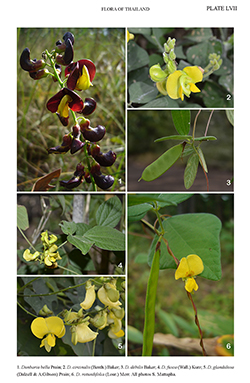e-Flora of Thailand
Volume 4 > Part 3.3 > Year 2023 > Page 558 > Leguminosae-Papilionoideae > Dunbaria
8. Dunbaria rotundifolia (Lour.) Merr.wfo-0000194173
Philip. J. Sci. 15: 242. 1919; Thuân, Fl. Cambodge, Laos & Vietnam 17: 121, pl. 18, f. 1. 1979; Craib, Fl. Siam. 1(3): 377. 1928; R.Sha & M.G.Gilbert in C.Y.Wu et al., Fl. China 10: 229. 2010.— Indigofera rotundifolia Lour., Fl. Cochinch. 2: 458. 1790. Plate LVII: 6.
Accepted Name : Dunbaria punctata (Wight & Arn.) Benth.
Pl. Jungh. 2: 242. 1852; Maesen, Agric. Univ. Wageningen Pap. 98(1): 76, f.9(1). 1998.— Dolichos punctata Wight & Arn., Prodr. Fl. Ind. Orient. 1: 247. 1834.— Atylosia punctata (Wight & Arn.) Dalzell, J. Linn. Soc., Bot. 13: 186. 1872.
Synonyms & Citations :
Description : Climber; young twigs, 1.5–2 cm long, hairy. Stipules narrowly lanceolate, ca 2 by 0.5 mm, margin hairy, outside hairy, inside glabrous, caducous. Leaves: petioles 1–2 cm long; rachis 0.5–0.7 cm long, winged. Leaflets: petiolules 1.5 mm long; blade ovate, 2–3 by 1.5–3 cm, terminal leaflet slightly larger, chartaceous, base rounded or emarginate, apex acute, margin entire, both surfaces hairy and glandular; lateral veins 3–4 pairs; stipels narrowly lanceolate, caducous. Pseudoracemes axillary and terminal, up to ca 5 mm long, 2–4-flowered, with 1–2 flowers per node; bracts narrowly lanceolate, ca 2 by 0.5 mm, apex acuminate, margin hairy, outside hairy, inside glabrous. Calyx: tube ca 2 mm long; lobes lanceolate, 3–4 by 1.5 mm, apex acute, margin hairy, outside densely hairy and glandular, inside glabrous; upper lobes connate, slightly separate at tip. Corolla yellow; standard orbicular 7–8 by 7–8 mm, base auriculate, basal callosities present, apex cordate, margin entire, both sides glabrous, claw 2 mm long; wings 6–7 by 3 mm, apex obtuse, margin entire, both sides glabrous, claw ca 2 mm, base auriculate ca 1 mm long; keel strongly curved, irregular, 6–7 by ca 3 mm, apex obtuse, base oblique, margin entire, both sides glabrous, claw 3 mm long. Stamens: tube 5–7 mm long, glabrous; filaments 3–4 mm long; anthers ca 0.5 by 0.5 mm. Ovary densely hairy and glandular; style 5–6 mm long, glabrous, hairy at base. Pods laterally compressed 3.5–4 by 0.9–1 cm, hairy and glandular. Seeds 8–10, globose, ca 3 by 3 mm.
Thailand : NORTHERN: Chiang Mai (Doi Suthep), Tak (Kaeng Huai Tak Forest Park); NORTH-EASTERN: Phetchabun (Nam Nao NP), Loei (Phu Ruea NP), Sakon Nakhon (Phu Phan NP), Mukdahan (Phu Pha Thoep NP), Maha Sarakham, Khon Kaen; EASTERN: Chaiyaphum (Phu Khiao WS), Nakhon Ratchasima (Pak Thong Chai), Ubon Ratchathani (Khong Chiam); SOUTH-WESTERN: Kanchanaburi (Sisawat), Phetchaburi (Cha-am), Prachuap Khiri Khan (Hua Hin); SOUTH-EASTERN: Rayong.
Distribution : India, Nepal, Bangladesh, Myanmar, China (type), Laos, Vietnam, Indonesia, the Philippines, Australia.
Ecology : Open areas, in deciduous dipterocarp forest and bamboo thicket; 30–500 m alt. Flowering: October–November; fruiting: December–February.
Vernacular : Khrang um phai (ครั่งอำไพ).

